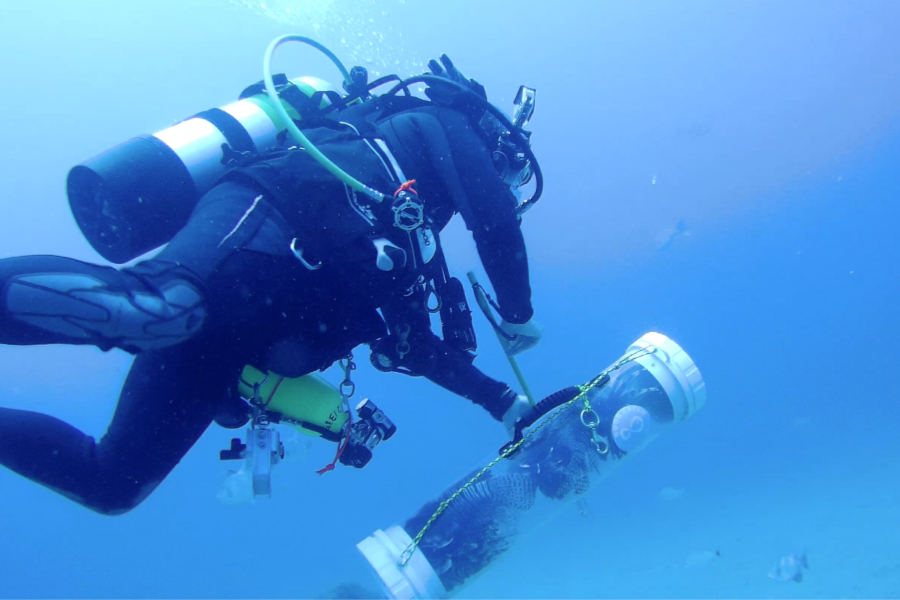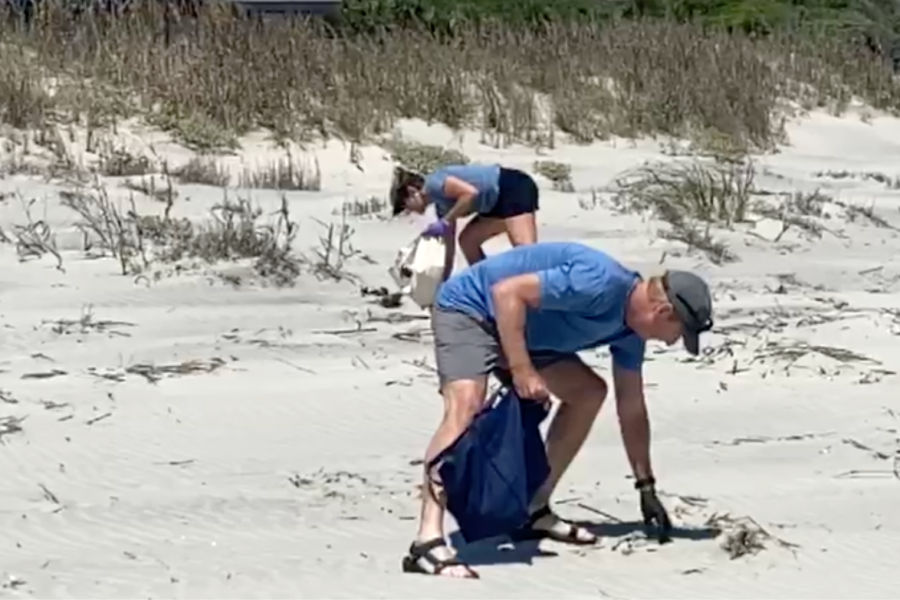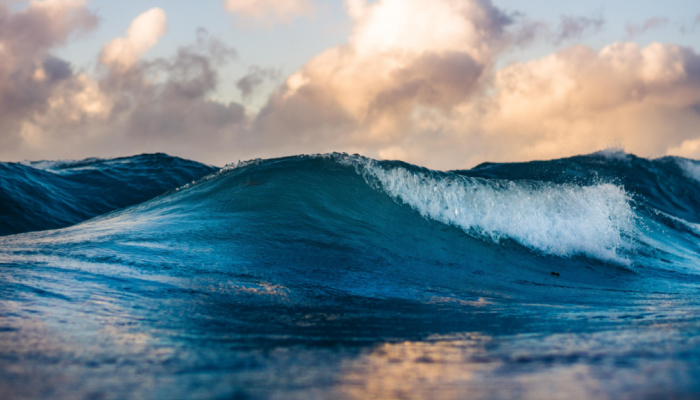No matter where you reside, you are tied to the ocean. She is the connective thread between countries, communities and cultures around the globe. She is equal parts calm and wild, shallow and cavernous, tough and fragile. She offers sanctuary for creatures big and small, sustaining life both above and below the surface. She serves as the fluid bridge between the economy and the environment. Without the ocean, our world as we know it would cease to exist. Humankind depends on a healthy ocean, and accountability starts with us. To honor National Ocean Month this June, join us in doing #fourfortheocean – four actions to take part in to support a healthy ocean!
FOUR THINGS WE’RE DOING TO PROTECT THE OCEAN
We’re combating climate impacts and creating space for conversation.

Aquarium staff partake in fieldwork efforts to restore and cultivate green infrastructure that has been decimated from climate impacts. One day, you might find us trudging through the pluff mud carrying bagged oyster shells, ready to lay the foundation for future oyster reefs that will stabilize our shorelines from the changing tides. On another day, we might be in that same substrate, but this time with shovels in hand planting saltmarsh grass as another line of defense.
We participate in collaborative meetings between other stakeholders where we’re sharing our expertise, like with our recent involvement with the Charleston Climate Action Plan, a comprehensive blueprint to strategically address the climate crisis in the City of Charleston. Or we’re leading conversations with at-risk communities through our Resilience Initiative for Coastal Education, listening to their concerns and adapting our actions to accommodate, such as creating engagement tools like the Sea Rise project for folks to contribute observations of flooding, erosion and more.
We’re saving species.
Sea turtles have swum the open seas for millions of years, offering us critical insights into the changing seascape along the way. But, in the last 200 years alone, human activity has tipped the scales against their survival, and we’re at risk of losing these sentinel species. Enter: our biologists and veterinary staff. They’re on-call at all hours, prepared to respond to a sick or injured sea turtle brought to us by the South Carolina Department of Natural Resources (SCDNR). Once they arrive at our working hospital, the Sea Turtle Care Center™, it’s all-hands-on-deck to offer top-notch care to these charismatic creatures through rescue and rehabilitation, eventually sending them on their journey home via releases.

We’re not alone in this work; in fact, we’re a part of a nationwide network of zoos and aquariums participating in sea turtle conservation through the Association of Zoos and Aquariums Saving Animals From Extinction (AZA SAFE) program.
We’re safeguarding biodiversity and a balanced ocean through science.
There isn’t a one-size-fits-all solution for sustaining healthy oceans. Here in South Carolina, we’ve gotten a bit creative with our offshore assistance. While we lack brightly colored coral formations off our coast, the sandy bottom habitats we do have are prime grounds for SCDNR to conceptualize and create artificial reef systems. These artificial reefs offer shelter, protection and feeding grounds for local marine life.

Two of these, Areas 51 and 53, are designated marine protected areas (MPAS) that serve as the location of Reef Research, our offshore research program. In partnership with SCDNR, we piloted a project to study the impact of removing invasive lionfish from the MPAs to determine changes to the abundance and diversity of other species.
Recently, the United States set the first-ever national conservation goal to conserve 30% of lands, waters and ocean by 2030, collectively known as 30×30. Protecting special places like these MPAs and studying their efficacy – similar to what happens with national parks on land – helps create sanctuaries where wildlife can thrive and ecosystems are more resilient to climate change.
We’re purging plastic, both within our walls and well beyond them.
Plastic pollution is found pole to pole, frozen in the Arctic ice and sunken into deep ocean trenches. Locally, we find it throughout our Lowcountry landscapes and in our beloved sea turtles, too. Whether macro or micro in size, the impact is immense. Within our walls, we’ve eliminated single-use plastic such as straws, bottles and bags. But beyond them, we’ve been able to do much more.

Utilizing the Litter-Free Digital Journal, a litter tracking tool and project in the South Carolina Aquarium Citizen Science app, we’re able engage community members to remove litter and contribute data to track litter hot spots, determine commonly found items and more. By amplifying the science behind plastic pollution, we’re able to support community legislation to reduce it.
FOUR WAYS YOU CAN HELP
Consider carbon friendly alternatives.
As emissions have increased, the ocean has become hotter, more acidic and less habitable for fish and wildlife. Reducing emissions is critical for the future of a healthy ocean. For transportation needs, turn off your engine and take a bike or a hike instead. Engage in energy efficient practices, like limiting light use indoors and encouraging an energy-free hour in your household.
When in doubt, look to the ocean as a source of inspiration. It’s not just a victim of climate change; it can serve as a powerful solution to the problem. Ocean-based climate solutions, like restoring and conserving natural habitats, curbing pollution and managing fisheries and other natural resources in sustainable ways, can be the answer.
Protect what you love.
Whether it’s water, wildlife, wild places or one another, we all play a part in supporting a healthy ocean. Become an advocate in areas that matter most to you. Stay informed on issues and current events. Spend time researching what’s happening on the Hill. Yes, the saying is cliché… but knowledge truly IS power.
Support sea turtle conservation.
Keeping beaches clean and pristine, turning off beach-facing lights at night and filling in holes in the sand are great ways to give sea turtles a flipper up during their annual nesting seasons. What also makes a difference is a visit to us! Ticket revenue supports our lifesaving efforts to save sea turtles, and you get to see the care in action as well.
Keep it free of debris.
We’re talking about actions big and small – they do add up! Shift your daily routine to reduce your reliance on single-use plastic and introduce reusable alternatives into your lifestyle. Participate in litter sweeps or plan your own. Be sure to log your data in the Litter-Free Digital Journal and become part of a community of dedicated citizen scientists!
You can also learn about legislation to stem it at the source, like the Plastic Pellet Free Waters Act, which addresses nurdle pollution. Nurdles are plastic pellets about the size of a pea; billions are created to be melted down and molded into plastic goods. Nurdles are small, making them hard to contain as they are transferred from one location to another, and buoyant, resulting in them washing up on beaches and coastlines. Sadly, they can also be confused for food and make their way into stomachs of sea turtles and other marine life.
The ocean has given so much to us; let’s give back to her. Commit to the #fourfortheocean. Will you take the plunge and participate?


